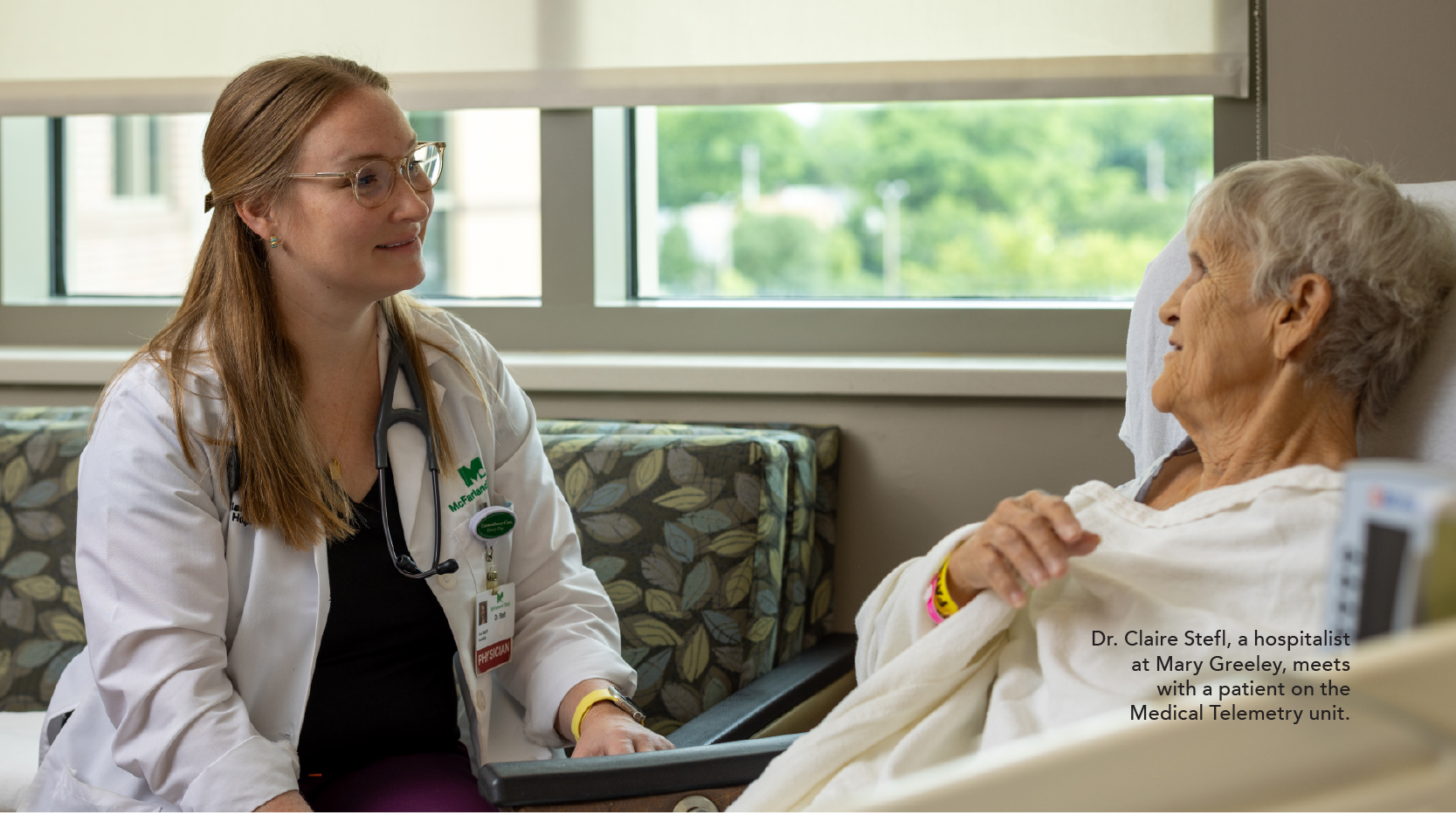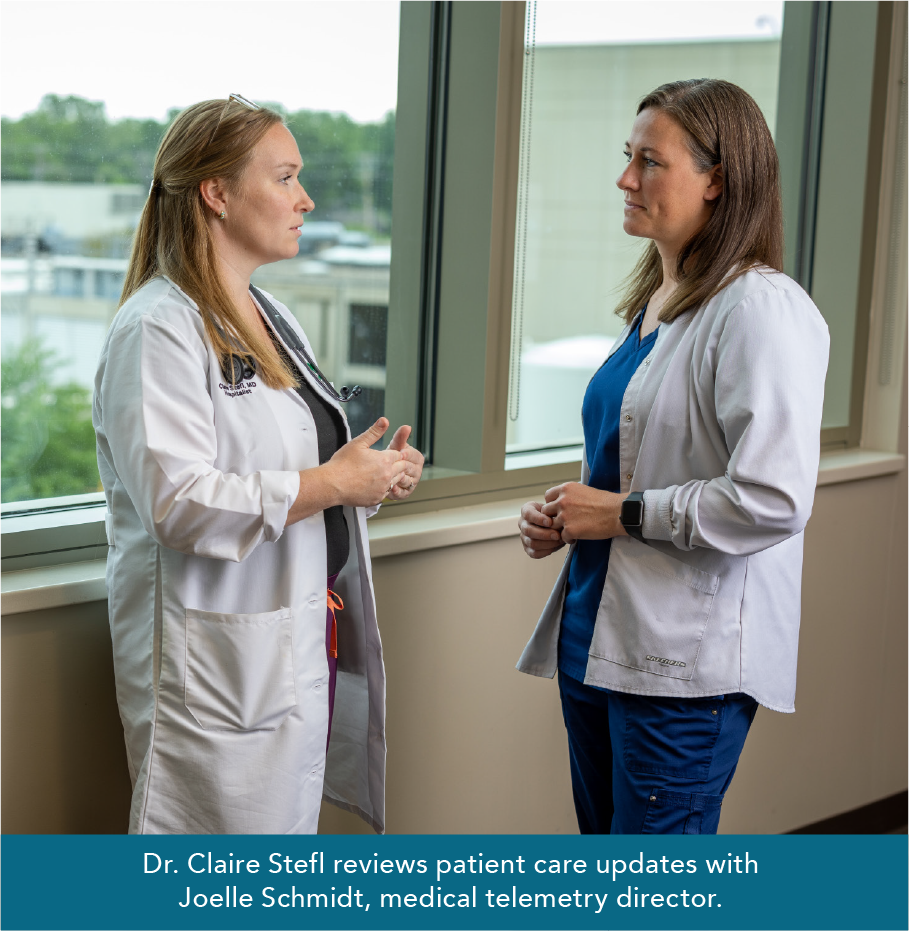What the heck is a Hospitalist?
Good question. Here’s the answer any patient will appreciate.

They might introduce themselves as your “admitting physician,” your “medical physician,” or maybe your “adult medicine doctor.”
They likely won’t introduce themselves as your “hospitalist.”
But Dr. Claire Stefl, Dr. William Barry, and their colleagues are, indeed, hospitalists who practice at Mary Greeley.
So why not just say “hospitalist?” Simple. Few people really know what the term means. And thus the motivation for this story.
“A lot of people don’t get what we do,” said Stefl. “I still have to explain it to my own grandmother.”
This is understandable as hospitalist is a relatively new specialty in healthcare.
Essentially, a hospitalist is a physician or nurse practitioner who only takes care of admitted hospital patients. They don’t have clinic hours but are at the hospital around the clock. They don’t treat patients in the Emergency Department or operating room. They are strictly focused on admitted patients.
Hospitalists at Mary Greeley help “ensure immediate response to patient needs, rapid intervention in emergencies, and consistent monitoring of patient progress,” said Joelle Schmidt, MSN, RN, director of medical telemetry. “They act as a central point of contact, which streamlines communication and coordination among various specialists, nursing staff, and other healthcare professionals—this reduces misunderstandings and delays, and enhances the overall efficiency of patient care. With hospitalists managing care throughout the hospital stay, patients and their families experience less confusion and more consistent communication. This continuity fosters trust and satisfaction with the care received.”
While there have been physicians who specialize in hospital care for quite some time, it wasn’t until 1996 when two physicians published a paper in the New England Journal of Medicine in which the term “hospitalist” was introduced.
“Hospitalists are a constant presence when you are in the hospital,” said Stefl. “We will consult with you every single day you are here. Your primary care doctor, the doctor who saw you in the Emergency Room—they hand you off to us when you are in the hospital and trust us to be a connection between them and you.”
Round and Round
 Mary Greeley hospitalists round on all inpatient units, except for the cancer unit where oncologists take care of patient rounding.
Mary Greeley hospitalists round on all inpatient units, except for the cancer unit where oncologists take care of patient rounding.
“Some organizations will have hospitalists who round in just one area, but that doesn’t work for us,” said Stefl. “We do it this way because we can admit patients and follow them on any given day from admissions from the Emergency Department and continue to follow them, no matter the unit where they are being treated. This also reduces the number of patient hand-offs between hospitalists and maintains continuity of care.”
Nursing staff, care coordinators, and social workers maintain excellent communication with the hospitalists, discussing patient care daily, said Schmidt.
“Nurses feel confident reaching out with questions, and hospitalists are often found in the departments, completing their documentation at the nurses’ station, making themselves readily available for any inquiries or assistance,” she said.
Room after room, patient after patient, Stefl navigates Mary Greeley’s inpatient floors, interacting with patients, assessing a variety of conditions, ordering medications, touching base with specialists, ordering tests, and putting together discharge orders. She is caring and engaging with each stop, as was illustrated on a morning in May.
Her first patient that morning was an elderly man who was admitted the day before.
“Your blood pressure looks better today, that’s why you were admitted yesterday,” she says, talking a little louder than she might otherwise to compensate for the patient’s hearing struggles. “We’re worried about your red blood cells though. We want to do a scope to look at your stomach to see if you are losing blood and if that is what is making you sick. We’re going to make sure it’s okay with your heart doctor first, though.”
The patient complains about his mouth being dry. She explains that he can’t eat anything because of his impending scope but promises to get something to moisten his mouth.
She compliments another patient on some yellow flowers someone brought her, with the patient noting that she also had “some beautiful peonies, dark red, but they gave up the ghost.” The patient notes that she feels ready to go home, and Stefl delivers the good news that she probably will leave the hospital that day. Unfortunately, the patient will need to go to an assisted living facility for additional care instead of to her own home.
“Things are going to be harder for you,” Stefl says gently. “You need some extra hands around.”
“I guess, I guess,” responds the patient.
Stefl moves on to the next room to see a patient who has been transferred from another hospital due to fluid buildup. She reminds him of the importance of wearing an oxygen mask, even while he sleeps.
“Without this, you get too much carbon dioxide in your bloodstream and lungs,” she warns. “Your body can’t get rid of it.”
She also notes that his legs are wrinkly, which indicates that he is losing some of the fluid buildup.
“The hospital is the only place where we get excited about wrinkles,” she jokes.
He talks about numbness and sciatic pain in his leg, which is likely the result of pressure from the fluid buildup. Stefl orders medication for the pain.
Despite it all, the patient is in good spirits and makes a point to note that Stefl and her colleagues on the floor “are all angels.”
Stefl became interested in being a hospitalist during her residency.
“It’s never the same day twice, and a little more fast-paced than being in a clinic, she said. “We’re coming to these patients on some of the worst days of their lives. We’re intervening to guide them to what you hope is a good outcome. There is such a range of conditions we see, you really have to be up to date on your medical knowledge.”
Hospitalist After Dark
Dr. William Barry is a nocturnist, which means he is a hospitalist who works nights. He is based in the Emergency Department from 7 p.m. to 7 a.m., handling the process for admitting patients who come through the ED.
“I manage chronic conditions and medication,” he said. “I do it in an Emergency Room setting as efficiently as possible to ensure we are getting the patient the appropriate care quickly.”
One evening in May, he could be found staring intently at a computer screen as he reviewed charts for a patient who was being transferred from Marshalltown. The patient had been treated for multiple gallstones and was experiencing severe upper abdominal pain, nausea, and chills. The patient might need to be evaluated for pancreatitis, Barry noted.
His intensely focused work will save time when the patient arrives in the Emergency Department and is subsequently admitted to a Mary Greeley inpatient floor. The patient’s fluids and medicines will already be ordered. It is this dedication to patients that helped earn Barry the 2024 Mary Greeley Physician of the Year award. The nomination praised Barry for elevating the role of a nocturnist at the hospital, and it noted that he “flies under the radar, taking excellent care of patients all night long. Everything is done by 7 a.m., from excellent documentation to orders for the next day and stabilization of unstable patients.”
Barry has been a hospitalist at Mary Greeley for 22 years, and he has been on the night shift for three. Like his colleague Stefl, he was drawn to the hospitalist role during an internal medicine residency.
“When I graduated from medical school, hospitalists were a new thing in the United States,” he said. “I was never really drawn to working in a clinic setting and found I really liked taking care of patients in the hospital.”
Barry can typically count on several admissions each evening. While he is a one-man band, he’s working alongside Mary Greeley Emergency Room doctors and nurses and can bounce things off of them.
“These are great people—talented and intelligent,” he said of his colleagues.
Like Stefl, he sees plenty of patients who are making return visits to the hospital.
“We become a familiar face for many patients, and they often recognize us,” he said.